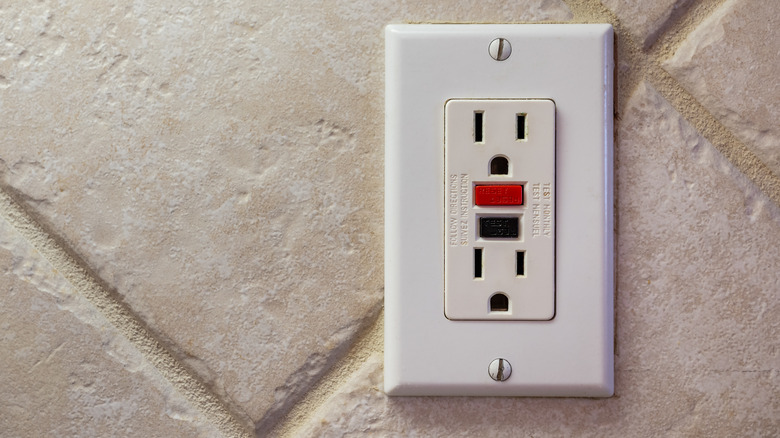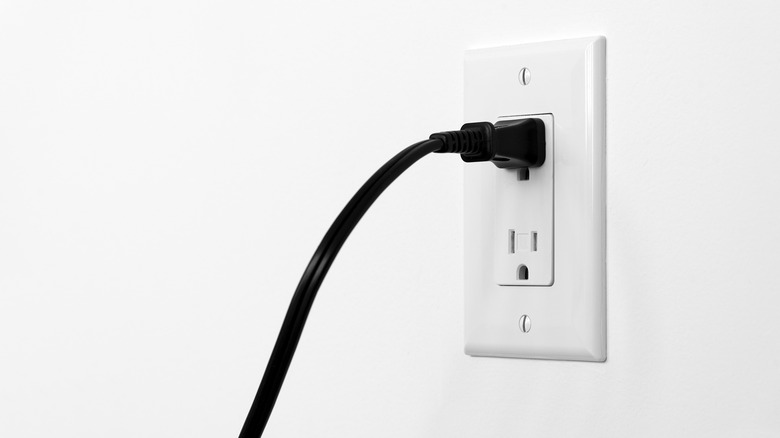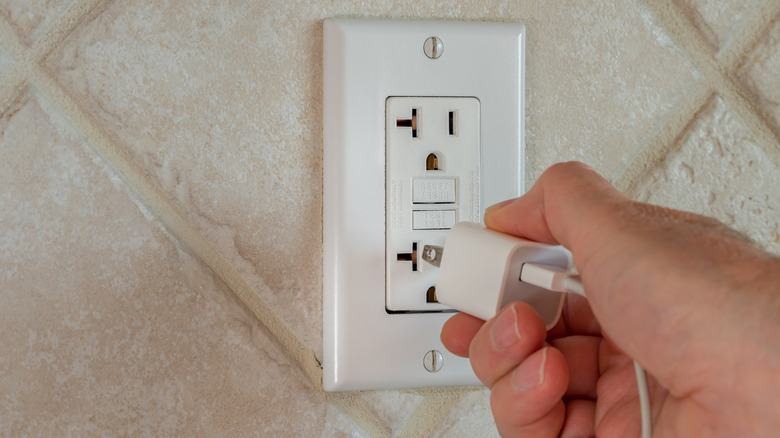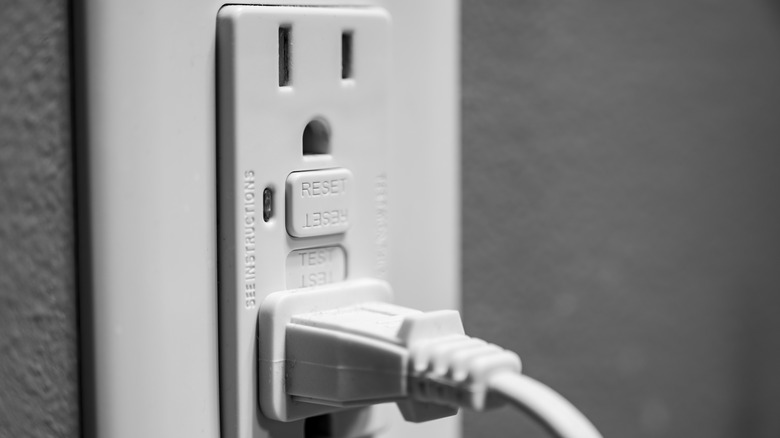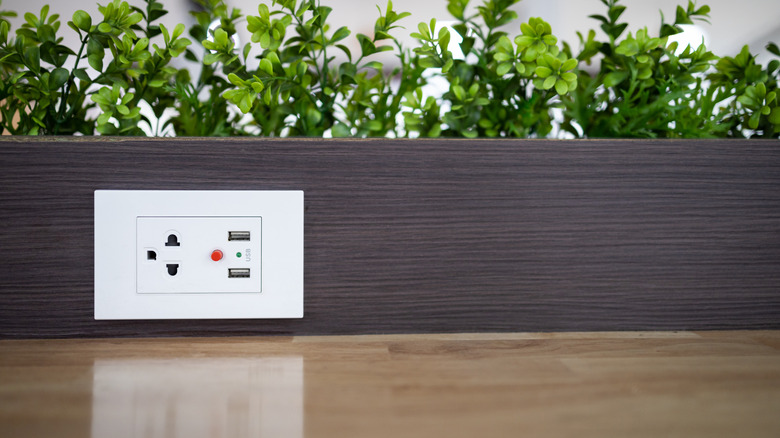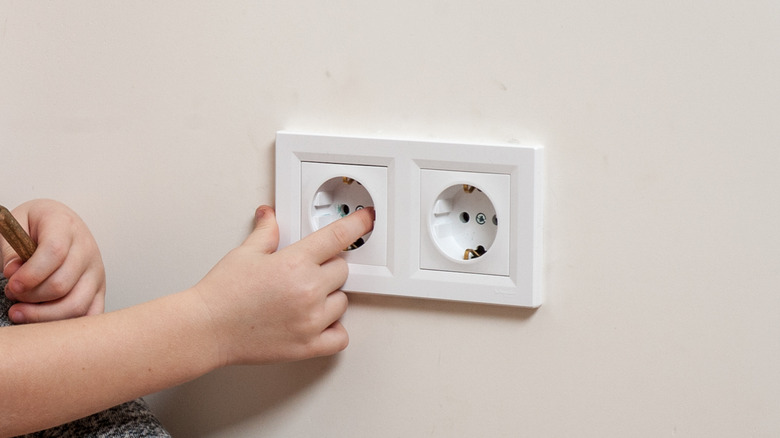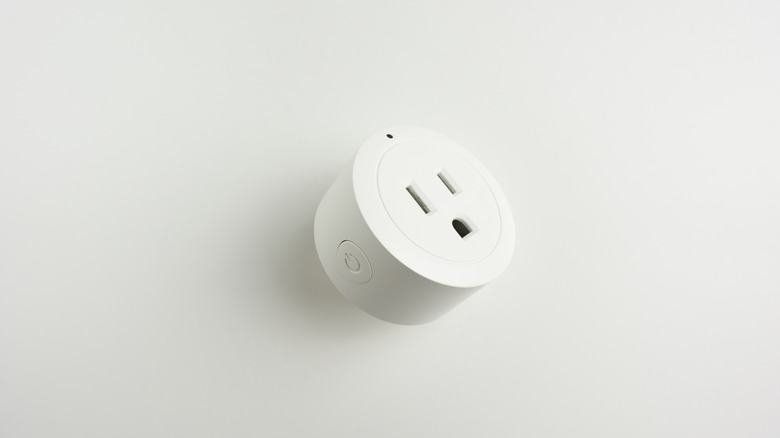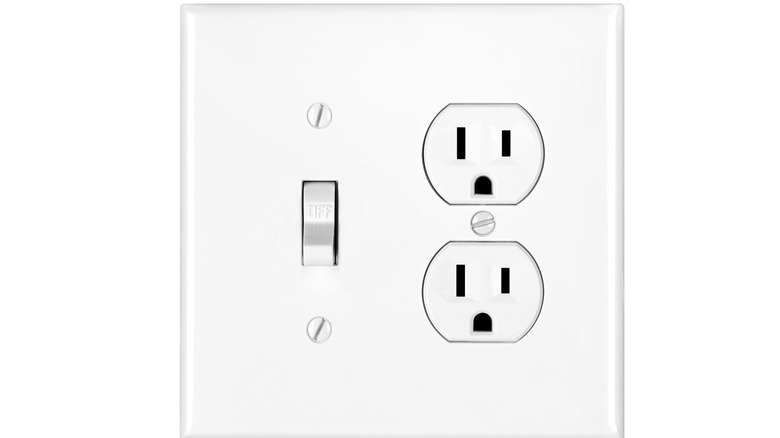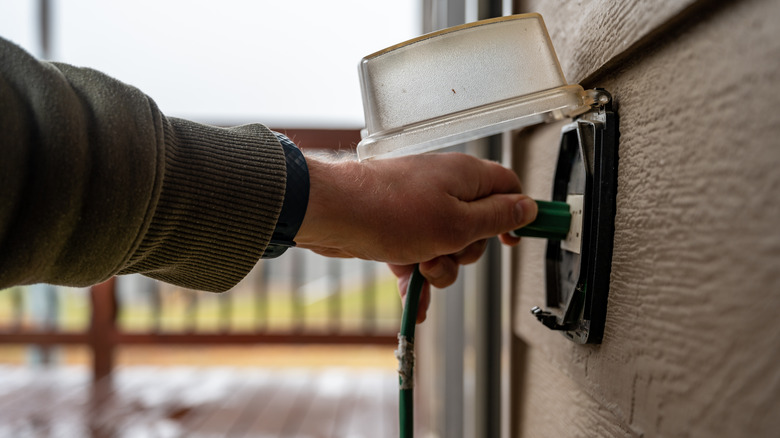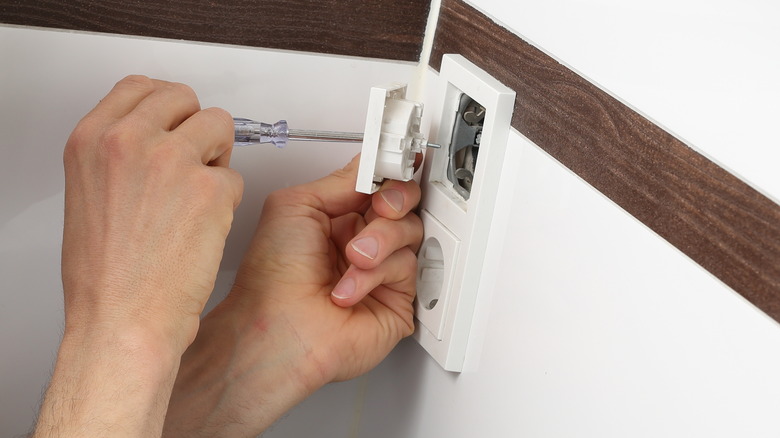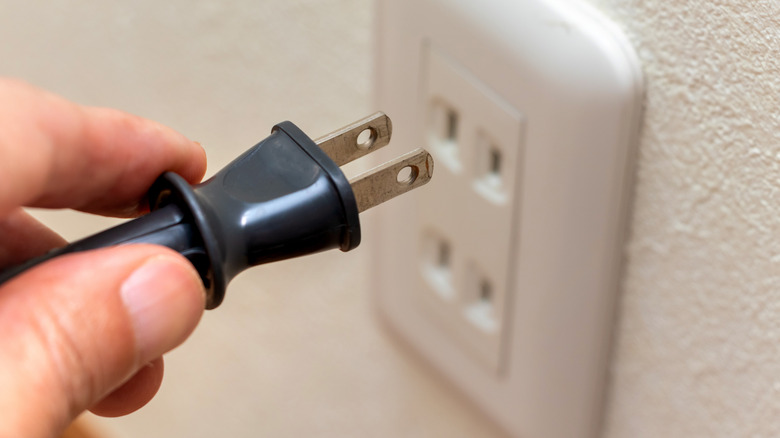10 Types Of Electrical Outlets Commonly Found In Every Home
All homes come equipped with several types of electrical outlets–all of which are designed to power your devices. While they may look the same at first glance, each serves a different purpose and may be more suitable for specific areas of the home, such as the bathroom, garage, or outdoor patio. Other electrical outlets may simply look better or offer additional perks compared to more traditional outlets. According to Bob Vila, choosing the right electrical outlet is essential since it can make your home more sustainable and minimize the risk of electrical hazards.
Fortunately, this guide will explain the ten most common types of electrical outlets found in every home. This way, you'll know what each one does, and you can make the necessary changes if needed. After reading this, you may have to take a trip to the home improvement store and pick up new hardware for your property.
15-AMP Outlets
The 15-AMP Duplex Receptacle is the standard outlet found in most homes in the United States, per Home Depot. 15-AMP receptacles are inexpensive, which is also a major reason they're installed in many properties. In many cases, these electrical outlets have three slots where the devices can be plugged into. The first, longer slot is neutral, the second slot is shorter, and the third slot is designed for grounding purposes.
Because of the lower amperage, they're ideal for electrical appliances that require less power, such as lamps. However, they can be easily upgraded to a higher quality outlet that can withstand the increased energy consumption of powerful appliances that may cause your electric bill to rise, like kitchen tools, space heaters, and more. If you're uncomfortable changing your home's 15-AMP outlets yourself, make sure to hire a professional electrician. This way, you save yourself the trouble and ensure the process is completed safely.
20-AMP Outlets
20-AMP outlets look like their 15-AMP counterpart, but you can tell them apart by the little t-shape prong that sticks out from the longer electrical slot. These outlets can support appliances that require a more significant amount of power, such as an air fryer, portable washing machines, and computers. According to Penna Electric, this can prevent electronics and appliances that need a lot of energy from overloading the outlet and tripping the breaker. Common areas where 20-AMP outlets are installed include your bedroom, garage, living room, dining room, and kitchen.
You'll find 20-AMP outlets at several home improvement stores and at different price points. In many cases, these receptacles cost between $3 to $20, depending on the brand and model. While installing 20-AMP receptacles may look easy, it's important to ensure you install them correctly. Doing so can prevent electrical hazards from damaging your home, which can pose a threat to your safety and finances.
AFCI Outlets
AFCI outlets, also known as Arc Fault Receptacle outlets, are electrical outlets that can reduce the risk of electrical fires due to arcing caused by damaged or loose wiring, according to the National Electrical Manufacturers Association. Damaged and loose wires can be caused by rats inappropriately chewing on them or a person driving a nail through them. Arcing can cause the receptacle to overheat, thus increasing the likelihood of an accident. Like GFCI outlets, AFCI outlets are also designed with "RESET" and "TEST" buttons.
Because of the added safety measures that AFCI outlets provide, it's recommended that they be installed in your home. These types of outlets can be especially valuable in areas where you may not be able to hear or see the outlet overheating. For example, if the outlet is becoming too hot and is emitting a sound in your bedroom, you may not notice it while sleeping until it's too late.
USB Outlets
USB outlets feature a built-in USB port so that you can conveniently charge your electronic devices. So, if you're someone who is always misplacing the little box of your charger, then having a few USB outlets in your home would be perfect. These types of outlets are also beneficial to have in common areas and guest bedrooms. This way, guests won't have to bother you if they forgot their charger at home and need to power up their phones, fitness watches, speakers, or tablets.
According to the New York Times, outlets with USB ports are inexpensive, allowing you to upgrade outdated electrical receptacles without breaking the bank. The cost for USB outlets can range between $18 to $55. How much you pay for one will depend on the brand, quality, and other important factors. Plus, replacing older outlets is easy and only requires you to follow a few simple steps.
Tamper-Resistant Receptacle Outlets
According to Bob Vila, many places require tamper-resistant receptacle outlets to be included in new construction homes. This is because these types of electrical outlets prevent foreign objects from being inserted into the slots, making them a safer option for many homeowners living with curious children. To ensure foreign objects, such as pens, forks, and knives, don't pose a hazard and cause serious injuries, tamper-resistant outlets are specially designed with a shutter that only opens when a suitable plug is inserted.
The National Fire Protection Association states that approximately 2,400 children sustain injuries, and six to 12 children die annually due to inserting items into an outlet. So, this type of electrical outlet could minimize their risk of injury and potentially save their life. Don't hesitate to speak with an electrician about updating your older outlets to tamper-resistant receptacle outlets if kids live in the home or children will be visiting your property.
Smart Outlets
New construction homes are typically equipped with smart outlets and other types of modern tech. Smart outlets are simply outlets that can power on or turn off the devices plugged in automatically. For example, instead of getting up to turn off a tower fan in the middle of the night, you can grab your phone and access an app to cut the power. The New York Times states that some smart outlets can even monitor your electricity consumption. This allows you to keep your energy usage low and below your spending means.
However, one common complaint of smart outlets is that they aren't visually appealing. This is because in-wall smart outlets stick out slightly and aren't flush against the wall. Plus, these receptacle outlets are often more expensive than traditional outlets. At home improvement stores, these in-wall outlets can cost anywhere between $20 to $180. They may also not be suitable for appliances that require a lot of power.
Combination Outlets
Combination outlets feature a switch to shut the power on and off in a room and an outlet to plug in your electronic devices. According to Better Homes & Gardens, the switch that's built into the combination outlet can be used to control several items in your home, including lights and exhaust fans. They simply have to be routed to the device you want. The best part about these switches is that you can often find them in different styles. This way, you can identify the right one for your home's aesthetic. Another benefit is that they're affordable. You can purchase several combination, or switch, outlets at home improvement stores for as little as $8. More expensive combination receptacles can cost you up to $31.
You can find combination outlets in various areas of the home, including hallways, garages, living rooms, bedrooms, and dining rooms. However, you may need the help of an experienced electrician to wire the receptacle properly.
Weather-Resistant Receptacle Outlet
As the name implies, weather-resistant receptacle outlets are outlets that can minimize the risk of electrical hazards caused by moisture. According to Eaton, this includes rain, ice, snow, and humid conditions. Weather-resistant receptacles typically have a cover that can further protect the outlet from water damage. Having this plastic cover on your outlet is extremely important since it can ensure large amounts of water don't enter the slots of the outlet. You may have seen these types of electrical outlets outside in your patio, porch, front yard, basement. Weather-resistant outlets are excellent to use if you're looking for an outlet to plug in your porch lights.
Unlike other outlets, weather-resistant receptacles are specially designed with a "WR" stamp. This stamp is often located on the top corner of an outlet's faceplate. Eaton also states that weather-resistant receptacles are made with components that can withstand humidity. With a weather-resistant outlet, you can protect your home from wet weather conditions that may be hazardous for other types of receptacles.
GFCI Outlets
GFCI outlets, or Ground Fault Circuit Interrupter outlets, are primarily used in areas of the home where water is close by, Coyne College explains. So, you may have seen them located in your bathroom, kitchen, or laundry room–mainly because they're also required by new home construction laws. GFCI outlets are equipped with slots that look similar to traditional 15- and 20-AMP outlets. However, one major difference is that it features a "RESET" and "TEST" button.
These types of outlets are safe to use in such areas because they're specially designed to monitor and stop electrical currents if surges occur due to contact with water. By doing so, it can help prevent electrical hazards on your property. For example, say you dropped a hair straightener into a bathtub full of water. If the outlet is functioning correctly, it would cut the power right away. While they may be pricier than other outlets, they're a must-have for any homeowner.
Recessed Outlets
Lastly, recessed outlets are electrical receptacles that are caved in deeper into the wall, per Apartment Therapy. So, instead of having a traditional outlet that sticks out toward the room, recessed outlets are farther away. These types of outlets can be extremely beneficial, especially if you're trying to push furniture against the wall and want to ensure it's completely flush. Recessed outlets can also prevent cables from protruding and becoming damaged.
There are many places where you can install recessed outlets, including your living room, bedroom, kitchen, bathroom, garage, and laundry room. You can even install them outside if you have an appropriate cover. Plus, installation is pretty straightforward and can be done within a few minutes. However, if you're inexperienced, you may need additional assistance from a professional electrician. For the most part, you can purchase everything you need from your local hardware store. A recessed outlet is definitely a thing you should buy at Home Depot.
